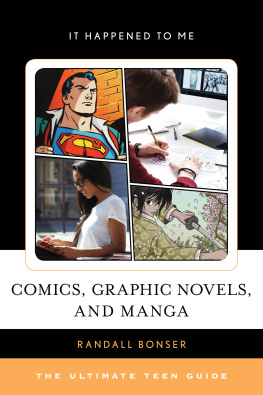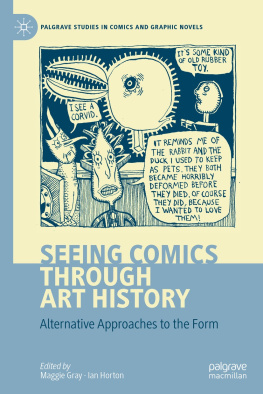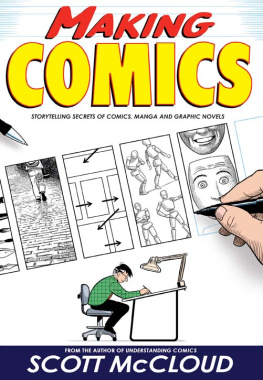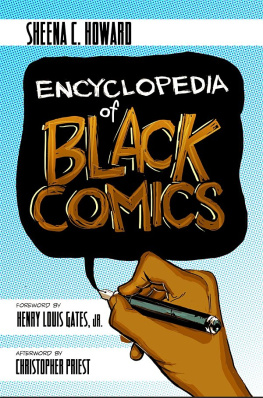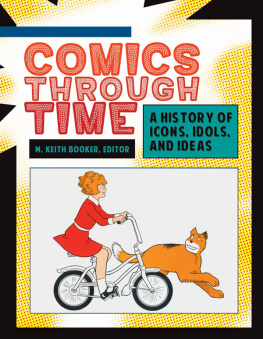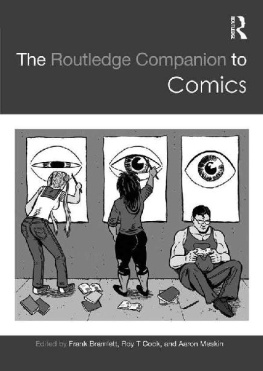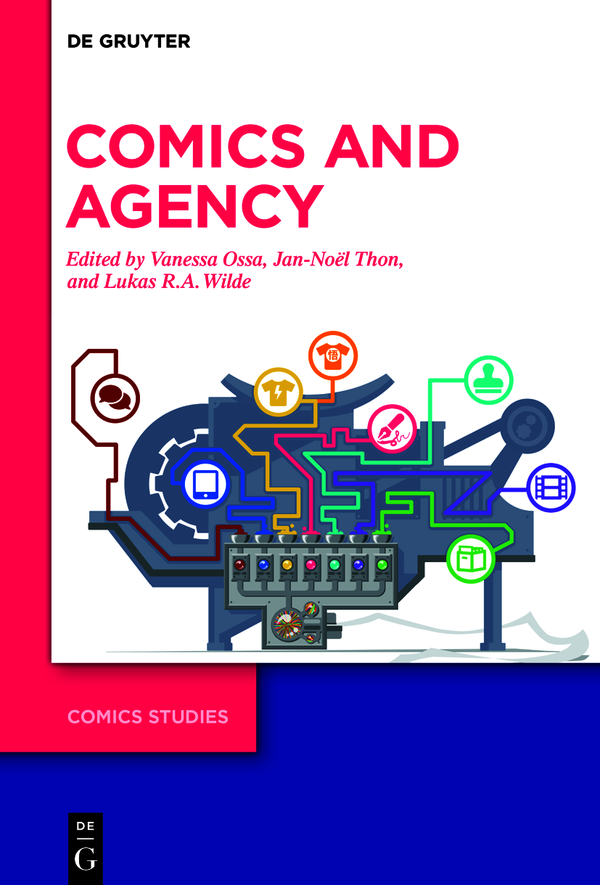Karl Ian U. Cheng Chua
The Deutsche Nationalbibliothek lists this publication in the Deutsche Nationalbibliografie; detailed bibliographic data are available on the Internet at http://dnb.dnb.de.
2022 the author(s), editing 2022 Vanessa Ossa, Jan-Nol Thon, and Lukas R.A. Wilde, published by Walter de Gruyter GmbH, Berlin/Boston
This work is licensed under the Creative Commons Attribution-NonCommercial-NoDerivatives 4.0 International License.
Comics and Agency
Introduction
Vanessa Ossa
Jan-Nol Thon
Lukas R.A. Wilde
When Marty Gold finished inking the pages that Joe had just completed, they would be strapped to the back of a motorcycle by the kid from Iroquois Color and carried along Broadway, down past Madison Square and Union Square and Wanamakers, to the Iroquois plant on Lafayette Street. There, one of four kindly, middle-aged women, two of whom were named Florence, would guess with surprising violence and aplomb at the proper coloration for the mashed noses, the burning Dorniers, the Steel Gauntlets diesel-driven suit of armor, and all the other things that Joe had drawn and Marty had inked. The big Heidelberg cameras with rotating three-color lenses would photograph the colored pages, and the negatives, one cyan, one magenta, one yellow, would be screened by the squinting old Italian engraver, Mr. Petto, with his corny green celluloid visor. The resulting color halftones would be shipped uptown once more, along the ramifying arterials, to the huge loft building at West Forty-seventh and Eleventh, where men in square hats of folded newsprint labored at the great steam presses to publish the news of Joes rapturous hatred of the German Reich, so that it could be borne once more into the streets of New York, this time in the form of folded and stapled comic books, lashed with twine into a thousand little bundles that would be hauled by the vans of Seaboard News to the newsstands and candy stores of the city, to the outermost edges of its boroughs and beyond, where they would be hung up like laundry or marriage banns from wire display racks.
(, 7475)
This elaborate description by Michael Chabon traces the complicated paths taken by the drawings of Joe Kavalier, protagonist of Chabons Pulitzer Prize-winning novel The Amazing Adventures of Cavalier & Clay (, 575). Less apparent, but perhaps most influential on the lives of Joe and Clay as well as on their creations are the millions of anonymous readers, some of which become only visible through their different stances on The Escapist comics. Their engagement ranges from fannish enthusiasm over political zeal to the admiration of fellow artists from other media, and finally to a Senate Judiciary Committee hearing in which Joe is accused of the encouragement of juvenile delinquency by promoting homosexuality through his work. Cameo appearances of (and references to) Dr. Fredric Wertham, Joe Shuster, Bob Kane, and Orson Welles notwithstanding, Chabons account of twentieth-century comics and media history is clearly fictional. It nevertheless articulates a precise question in literary form: Where does agency reside within these networks of production, distribution, and reception surrounding The Escapist, and how do the fictional character and his adventures as they are represented in comics and in other media forms influence, shape, and transform the currents of individuals, companies, and perhaps US history itself?
Comics and Agency
Notions of agency distributed by semiotic, technological, and sociocultural means among the heterogeneous actors surrounding comics as an assemblage or a dispositive certainly require further investigation. The concept has proven indispensable in a wide range of disciplines for determining processes of mutual influences and responsibilities for specific actions. Fields of study extend from political science to anthropology and ethics, all strongly influenced by sociology, as one of the latters basic questions has long been how the agency of individuals can be conceived in opposition to social structures ():
Media Studies are usually concerned with the economic, social, and political conditions of the production of media, the analysis of media content, the reception and consumption of media products including the characteristics of users of media, and finally, the critique of media in general from a cultural and historical perspective.
(, 20, original emphases)
Approaches to mediating and mediated agency were first developed in response to Actor-Network-Theory (ANT), which has been booming since the 1990s (). According to all these new materialisms, agency can not only be attributed to natural persons, but also to things as heterogeneous as materialities, devices, inscriptions, institutions, or programs within complex configurations or assemblages.
For Latour, all and any entities are to be treated indifferently in ontological terms, as mere quasi-objects, fleeting nodes of distributed agency (, 4) precedes an identification of subjects vs. objects as well as stable domains such as nature vs. culture or human vs. technology.
The fifteenth annual conference of the German Society for Comic Studies (ComFor), Comics and Agency: Actors, Publics, Participation, focused specifically on the interrelations between (groups of) individual, collective, institutional, and corporate actors of comics (including graphic novels, manga, cartoons, and other forms of sequential or cartoonish images). Even if many classifications in the world of comics such as the distinction between authors and readers seem less salient from this point of view as producers may have once been consumers and readers easily become authors and artists themselves they are distinguishable through a particular distribution of agency within historically evolving media configurations. If readers, authors, or editors comment on or add to an existing work, they operate within different dimensions of agency defined by their possibilities to influence, alter, or shape other actants in the network. Agency is at stake when audiences resist hegemonic meanings and interpretations of multimodal texts in order to assume opposing positions. In the same manner, authorship could be understood as the attribution of agency to and across various medial instances and roles such as writers, artists, colorists, letterers, or editors, as well as commercial rights holders such as publishing houses or conglomerates (for US superhero comics, see, e.g., ).
Comics and Mediality
In order to provide a brief overview of possible dimensions of comics and mediating/mediated agency (which draws on ), without prioritizing certain projects, interests, and terminologies over others.
, 22). In a subsequent agentic analysis, the corresponding meanings could be reconstructed with recourse to specific actors and their interpretative authority according to social and institutional roles. A variety of different methods are available for this purpose, from semiotics-based textual analysis to empirical reception research.


